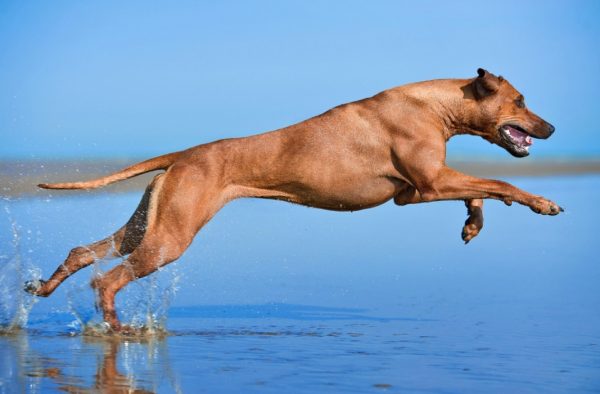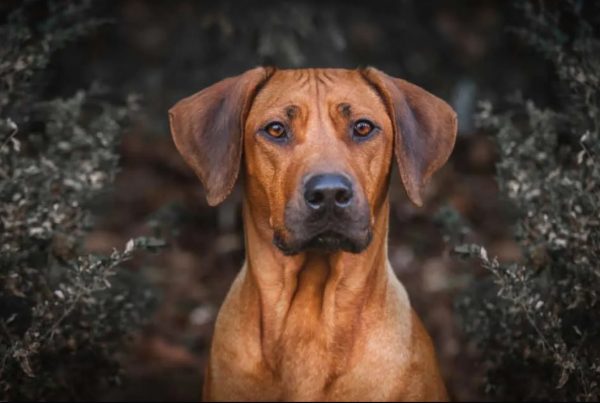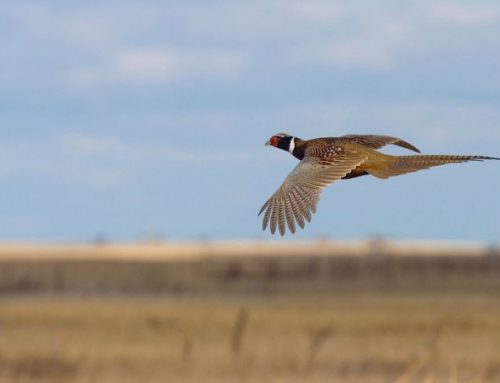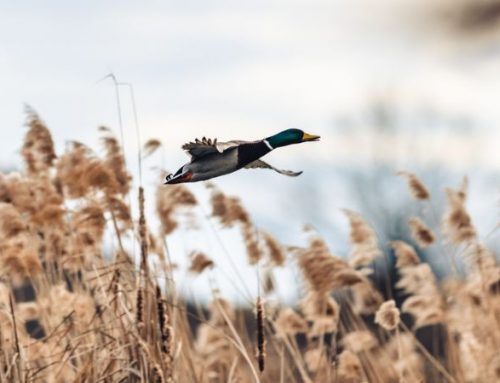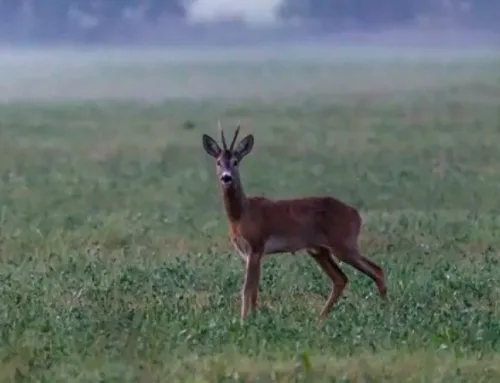The Rhodesian Ridgeback, famous as the lion hunting dog, with its large and muscular breed, is renowned for its endurance and ability to cover long distances without tiring. Its distinctive feature is the ridge of hair growing in the opposite direction along its back.
Known for their intelligence, courage, and protective nature, rhodesian ridgebacks are ideal for hunting large predators like lions and leopards.
These dog, the lion hunting ones, are known for their stamina, speed, and agility. These traits make them excellent partners in hunting expeditions. Their keen sense of smell and ability to work independently or in packs allow them to track and hold large game at bay until the hunter arrives. Their protective nature ensures they are fearless when facing dangerous animals, making them invaluable in the hunt for big game.
In some African cultures, it was believed that Rhodesian Ridgebacks had a unique connection to the night. Stories claimed these dogs could perceive things beyond human senses, such as spirits or malevolent presences, and would protect their families from unseen dangers.
Origins and History of this lion hunting dog
The Rhodesian Ridgeback lion hound originates from the southern region of Africa. It is believed that the first ridgeback dogs arrived in Rhodesia, now Zimbabwe, through various migrations of tribes, including the Khoi-Khoi, also known as the Hottentots. These tribes journeyed from the Middle East to the African coasts, bringing their animals, among which were likely the ancestors of the modern Rhodesian Ridgeback.
The Khoi-Khoi led a pastoral life, using their dogs to protect their livestock from predators. The current Rhodesian Ridgeback lineage is thought to descend from these early dogs. Evidence supporting this hypothesis includes depictions of the Khoi-Khoi dog in Dr. David Livingstone’s “Livingstone’s Missionary Travels in South Africa,” published in 1875. This book illustrates a maned dog among the Hottentot herders and their cattle.
However, descriptions from that time indicate that the maned dog of the Khoi-Khoi differed in appearance from today’s Rhodesian Ridgeback. It resembled more of a Spitz-type dog, similar to a jackal. These dogs were rustic and resilient, able to withstand the harsh climatic conditions of Africa, including temperature fluctuations between day and night, food scarcity, and common regional diseases.
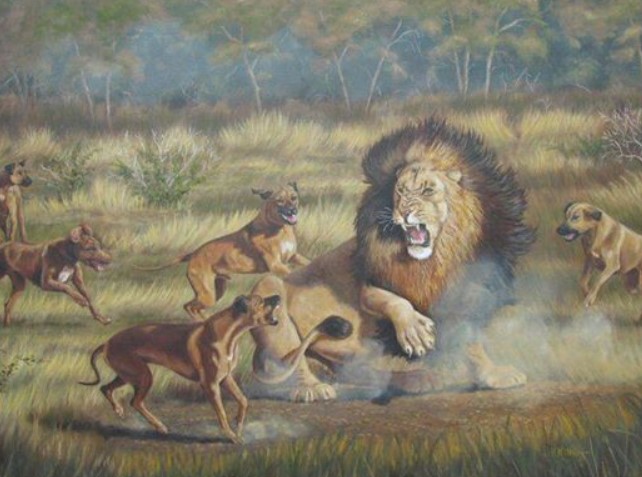
Evolution and Development
The fascinating story of the Rhodesian Ridgeback lion houndcontinues with the arrival of Dutch and British settlers in South Africa. These colonists brought various breeds of hunting dogs from Europe. However, they soon realized that their dogs were not well-suited to the tough African environment. The settlers were impressed by the primitive Khoi-Khoi dogs’ abilities and qualities, deciding to crossbreed them with their European dogs to enhance their characteristics and performance.
This crossbreeding led to the development of the Boer dogs, crestback hunting dogs highly valued by big game hunters. The result was the Rhodesian Ridgeback, a dog perfectly adapted to the African terrain, capable of tracking and cornering large predators such as lions.
In 1875, missionary Charles Helm founded the “Hope Fountain” mission in Matabeleland, Rhodesia, bringing with him two ridgeback-type Greyhounds named Powder and Lorna. Hope Fountain, established by Helm, became a crucial stop for all hunters venturing into Zimbabwe, including the renowned big game hunter Cornelius Van Rooyen. Struck by Helm’s dogs, Van Rooyen decided to breed his own dogs with the missionary’s ridgebacks, enriching their bloodlines with various European breeds such as the Great Dane, Irish Terrier, Pointer, Mastiff, Deerhound, and Collie.
Over time, Van Rooyen continued to breed and refine his dogs, aiming to create specimens that were increasingly courageous, agile, resilient, and adept at hunting. Within a few years, his dogs became legendary and highly sought after by hunters. The primary goals of these crossbreeds were to enhance endurance and performance. The resulting dogs were particularly agile and resilient, powerful yet not heavy, possessing incredible courage tempered by an instinctive respect for Africa’s great prey. Used successfully by colonists for both hunting and defense, they became known as the “lion dog,” utilized by Africa’s great hunters.
A fascinating piece of information comes from researchers at the National Human Genome Research Institute in Bethesda, Maryland (USA). They examined the DNA of 1,346 dogs, reconstructing a detailed map of the relationships between various canine breeds. Their findings revealed a 70-89% genetic correlation between the Rhodesian Ridgeback and the Great Dane.
Cornelius Johannes van Rooyen, also known as “Nellis” van Rooyen was born in 1860 in Uitenhage, Cape Colony (now part of South Africa), van Rooyen was an early colonial settler in what was then called Rhodesia, now Zimbabwe.
The Legend of Lion Hunting
The true consecration of the Ridgeback came with its use in hunting Africa’s great predators, particularly the lion, from which it inherits its legendary nickname.
Contrary to popular belief, the Rhodesian Ridgeback did not attack the lion. Its task was far more complex and required courage, intelligence, and strategic skills: to locate the prey, keep it engaged, and “hold” it in place, forcing it to stop without ever making physical contact.
Working in small groups, the Ridgebacks would surround the lion, distract it, and apply constant pressure until the hunters arrived on horseback, armed with rifles. This specific hunting technique demanded a dog that was bold but never reckless, skilled in reading the prey’s reactions, capable of withstanding charges, and able to work as a team.
Many of the Ridgeback’s qualities still come from this heritage:
- a strong predatory instinct,
- great mental independence,
- exceptional physical endurance.
Hunting Lions with Rhodesian Ridgebacks
Hunting lions is an extremely dangerous activity that requires a deep understanding of lion behavior and meticulous preparation. Here’s how Rhodesian Ridgebacks are used in this high-adrenaline adventure:
Training: Rhodesian Ridgebacks are trained from a young age to track scents and work as a team. The training includes basic obedience, scent detection, and responding to the hunter’s commands in high-pressure situations.
Detection and Signaling: During the hunt, Rhodesian Ridgebacks use their keen sense of smell to detect the presence of a lion. Once they find a trail, they follow the lion cautiously, maintaining a safe distance to avoid startling it.
Isolation and Distraction: The primary task of the Rhodesian Ridgebacks is to isolate and distract the lion. When they find the lion, they work as a team to surround and keep it engaged. This allows the hunter to approach carefully and prepare for the shot. The dogs do not directly attack the lion but keep it occupied and confused with rapid, coordinated movements.
The Rhodesian Ridgeback’s incredible agility, endurance, and courage make it an invaluable partner in the dangerous pursuit of big game hunting. Their unique combination of traits ensures they remain a symbol of elegance and tenacity in the hunting world, continuing to uphold the legacy of their storied past.
Hunter Protection: In the face of danger, Rhodesian Ridgebacks lion hounds are ready to protect the hunter. Their presence reassures the hunter and provides an additional layer of security throughout the entire operation.
Teamwork: Hunting lions with Van Rooyen Lions dog requires impeccable teamwork between the dogs and the hunter. Mutual communication and trust are crucial for the success of the operation. The dogs must respond immediately to the hunter’s commands and quickly adapt to changing situations during the hunt.
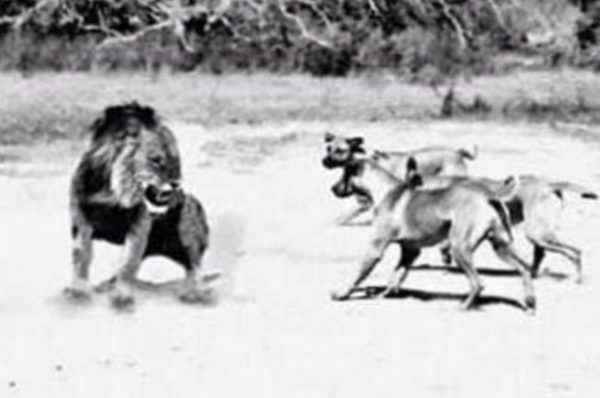
An old image of Rhodesian Ridgebacks hunting a lion
Hunting lions with Rhodesian Ridgebacks is an ancient tradition that highlights the courage, intelligence, and resilience of these extraordinary dogs. This practice demands great skill, respect for nature, and a deep understanding of animal behavior. Rhodesian Ridgebacks, with their historical connection to African hunting grounds, continue to be symbols of elegance, strength, and tenacity, making each hunt an unforgettable adventure.
The Rhodesian Ridgeback’s rich history and evolution from a primitive African dog to a modern hunting companion highlight its unique qualities. This breed’s intelligence, courage, and adaptability make it a symbol of elegance and tenacity in the hunting world. The Ridgeback remains a testament to the enduring bond between humans and dogs, thriving in the challenging landscapes of Africa and continuing to excel in its role as a premier hunting dog.
In the collective imagination, the Ridgeback is often thought to engage in hand-to-hand combat with the lion, but this is not true. Instead, its role is to hold the lion at bay, blocking and disorienting it until the hunter arrives. The Ridgeback uses its agility and intelligence to outmaneuver the lion, keeping it confused and at a distance without ever engaging in direct combat. This strategic approach allows the hunter to safely approach and take the necessary action. The breed’s true strength lies in its ability to manage and control dangerous situations through skill and cunning, rather than brute force
Fascinating Facts about Rhodesian Ridgebacks
- The ridge that makes the difference: Not all Rhodesian Ridgebacks possess the characteristic dorsal ridge. According to the Rhodesian Ridgeback Rescue, some dogs lack this distinctive feature due to a genetic fault. If your puppy is born without the ridge, it will never develop one.
- A hollywood star and his ridgebacks: The famous actor Errol Flynn, known for his role in the 1938 film “The Adventures of Robin Hood,” was among the first to breed Rhodesian Ridgebacks in America. Flynn began breeding these remarkable dogs in the 1930s, keeping them at his ranch in Hollywood.
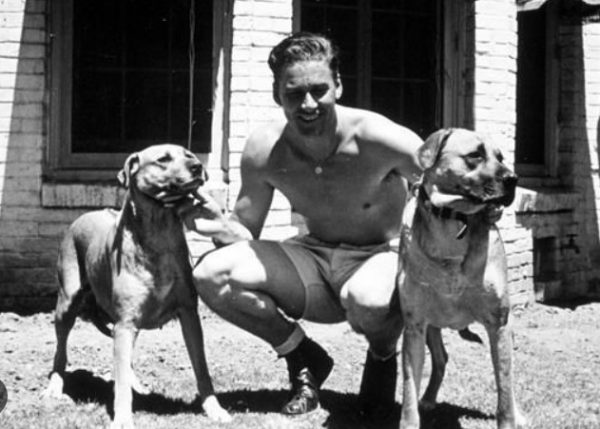
Famous actor Errol Flynn was a passionate breeder of Rhodesian Ridgback dogs
- Tireless Runners: Rhodesian ridgebacks are renowned for being excellent running companions, even ranking first on Outside’s list of the best running dogs. These dogs are not only resilient but also incredibly fast, capable of reaching speeds between 20 and 30 mph.
The Rhodesian Ridgeback in Movies, TV, and Popular Culture
The magnetic beauty and natural elegance of the Rhodesian Ridgeback have not gone unnoticed in the world of cinema, television, and literature. Over the years, this breed has appeared in several productions, often chosen for its proud demeanor and striking presence, capable of conveying strength and nobility.
One of the most iconic appearances is in the film “Goodbye Bafana” (2007), a story set in South Africa that tells the life of Nelson Mandela. The Rhodesian Ridgeback is shown in its native land, symbolizing the deep connection with Africa and the wild landscapes that shaped the breed.
The Ridgeback also appears in “The Lost World: Jurassic Park” (1997), the sequel to the famous Steven Spielberg saga, where a Ridgeback is part of the hunting team hired to capture the dinosaurs — a subtle nod to its heritage as a courageous and resilient hunting dog.
On television, the breed can be spotted in episodes of the classic series “Magnum P.I.”, while in literature, the Rhodesian Ridgeback is often mentioned in novels set in Africa, evoking adventure and exotic landscapes. A notable example is the book “Rhodesian Ridgeback: The Origin, History and Standard” by T.C. Hawley, still considered a reference for those wanting to deeply understand this extraordinary breed.
These appearances in media and popular culture have helped solidify the Rhodesian Ridgeback’s image as a symbol of elegance, pride, and a deep bond with the wild, making it one of the most admired and recognizable breeds, even beyond the hunting world.
The Rhodesian Ridgeback in Italy
Rhodesian Ridgebacks have become quite fashionable in the city of Milan, Italy.
These elegant and athletic dogs have caught the eye of many Milanese residents, particularly those who appreciate their unique appearance and loyal nature. The breed’s popularity in Milan is partly driven by their suitability for urban living combined with their strong, protective instincts, making them both stylish and functional companions.
As a result, if you are in Italy for hunting and you are spending some time to visit the italian fashion capital, it’s not uncommon to spot these striking dogs accompanying their owners in the chic streets like via Montenapoleone and parks of the city, adding to the fashionable atmosphere of Milan.
Despite its hunting history, the Rhodesian Ridgeback is now cherished as a loyal family companion. Known for its strong bond with household members, the breed maintains an independent character. Some stories even claim that Ridgebacks are so protective they can instantly sense the intentions of anyone entering the home, acting as silent yet vigilant guardians.
From the Heart of Africa to Homes and Hunting Reserves Around the World
The story of the Rhodesian Ridgeback is that of a dog born for big game hunting, hardened over centuries by the African sun and dust, and now able to win over hunters and enthusiasts worldwide with its strength, elegance, and intelligence.
From the African lion to the European wild boar, the Ridgeback has proven its remarkable adaptability, all while preserving the pride and courage that make it one of the most fascinating and legendary breeds in the world of hunting dogs.
Bottom line
As we wrap up this post, it’s impossible not to reflect on the unparalleled beauty and distinctive characteristics of the Rhodesian Ridgeback.
Known for their striking ridge of hair running against the grain along their back, these dogs are not just a visual marvel but also embody a perfect blend of strength, agility, and loyalty. Bred initially for hunting and guarding in the rugged landscapes of Africa, the Ridgeback carries a noble lineage that makes them both formidable protectors and gentle companions.
Whether you’re embarking on a hunting adventure or simply enjoying the great outdoors, the Rhodesian Ridgeback is a steadfast partner, embodying the spirit of adventure and the elegance of nature.
As you plan your next journey, consider the Ridgeback not just as a pet, but as a true companion that brings both beauty and bravery to every experience.
Rhodesian Ridgeback – 20 Expert FAQs About This Unique African Hunting Dog
What makes the Rhodesian Ridgeback such a special hunting companion?
Originally bred in Southern Africa to track and hold big game like lions at bay, the Ridgeback is known for its courage, athletic build, and intelligent independence. Unlike typical hunting breeds, it combines tracking instincts with a strong guarding nature—making it ideal for long days in the bush where both loyalty and boldness matter.
Is the Rhodesian Ridgeback still used for hunting today?
Absolutely. While many Ridgebacks now live as loyal family companions, skilled breeders in Africa and abroad continue to raise working lines. These dogs still excel in bush tracking, wild boar drives, and game recovery, especially in countries like Namibia, Zimbabwe, and South Africa.
What is the origin of the Ridgeback’s trademark “ridge”?
The distinctive ridge is a strip of hair along the back that grows in the opposite direction. It’s not just cosmetic—it’s a genetic hallmark of the breed, tracing back to indigenous African dogs bred with European hunting breeds during colonial times.
How big do Rhodesian Ridgebacks typically get?
Males generally stand 25–27 inches (63–69 cm) at the shoulder and weigh 85–100 pounds (39–45 kg). Females are slightly smaller. Their muscular frame is built for stamina and speed, crucial for covering vast savannahs during a hunt.
Are Ridgebacks good for first-time hunting dog owners?
While they are trainable and deeply loyal, Ridgebacks do best with experienced handlers who understand their independent spirit. They respond to respectful leadership, consistent routines, and mentally stimulating work—especially in a hunting context.
How should I train a Rhodesian Ridgeback for hunting?
Start early. Basic obedience, recall, and socialization are essential in the first year. Introduce them to the field in controlled environments, gradually exposing them to tracking, scent work, and bush terrain. Always use positive reinforcement—they don’t respond well to harsh methods.
What game species can Ridgebacks be used to hunt?
Originally developed to help hunters pursue lions, they are now more commonly used for wild boar, bushbuck, kudu, and other medium to large African game. Their silent tracking and strong presence make them excellent partners for spot-and-stalk hunting.
Are Ridgebacks aggressive dogs?
Not at all—when bred and raised correctly. They’re naturally reserved with strangers but deeply affectionate with their pack. They won’t start fights but won’t back down either. Their instinct is to protect, not provoke.
Do Rhodesian Ridgebacks get along with other dogs?
They can coexist peacefully with other dogs, especially if raised together. However, their dominant nature and high prey drive mean careful introductions and boundaries are key—especially in a hunting pack.
How much exercise does a hunting Ridgeback need?
Plenty. A Ridgeback thrives on daily physical and mental stimulation. Outside hunting season, long hikes, tracking games, and obedience drills keep them balanced. A bored Ridgeback is a destructive Ridgeback.
Is the Rhodesian Ridgeback suitable for hunting in Europe or North America?
Yes, with the right climate and terrain. Their endurance and tracking abilities adapt well to wild boar hunting in Europe, and in the U.S., they’ve been used for deer recovery and hog hunting, especially in the southern states.
Can a Ridgeback live in a family home when not hunting?
Definitely. They bond closely with their families and are calm indoors, provided they get proper exercise. They are gentle with children, but their size and strength call for supervision around smaller kids.
What’s the Ridgeback’s temperament like in the bush?
Focused, alert, and fearless. They work quietly, using scent to track and sight to locate game. Unlike bark-driven hounds, Ridgebacks are stealthy and strategic—ideal for creeping up on elusive prey.
Are Rhodesian Ridgebacks hypoallergenic or low-shedding?
They have a short, sleek coat that sheds moderately. While not hypoallergenic, they are relatively easy to groom—another plus for field conditions. A quick weekly brush keeps their coat healthy.
How long do Rhodesian Ridgebacks live?
A healthy Ridgeback can live 10 to 13 years, sometimes longer. Their robust constitution, when matched with good nutrition and regular veterinary care, makes them one of the hardiest large breeds.
What health issues should I be aware of in hunting Ridgebacks?
Hip dysplasia and dermoid sinus (a congenital skin condition) are the most known issues. Reputable breeders screen for these. As hunting dogs, they’re also prone to bush injuries, so check them after every outing.
What’s the best environment for a Ridgeback to thrive in?
Open spaces, access to nature, and a calm but structured home. They’re not suited for apartments or sedentary lifestyles. Think savannah, vineyards, mountain trails—anywhere they can roam and explore with you.
Do they require special feeding as active hunting dogs?
During the hunting season, yes. They benefit from high-protein diets that support muscle recovery and stamina. Supplements like omega‑3 and joint support can also help active dogs stay in peak form.
How did the breed gain recognition internationally?
First standardized in Southern Rhodesia in the 1920s, Ridgebacks were later recognized by the American Kennel Club in 1955. Their popularity surged among hunters and outdoorsmen for their loyalty and versatility.
Why choose a Rhodesian Ridgeback for African big game hunting?
Because you need a dog that’s as rugged, intelligent, and fearless as the land you’re hunting on. The Ridgeback doesn’t just follow you into the wild, he understands it, respects it, and helps you navigate it with ancient instincts and unwavering loyalty.


